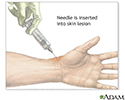Skin lesion aspiration
Skin lesion aspiration is the withdrawal of fluid from a skin lesion (sore).
Skin lesion
Rashes involve changes in the color, feeling or texture of your skin.

How the Test is Performed
A needle is put into skin sore or skin abscess , which may contain fluid or pus. The fluid may be examined under a microscope. A sample of the fluid may also be sent to a lab. There, it is put in a lab dish (called a culture medium) and watched for growth of bacteria or fungi.
Skin abscess
A skin abscess is a buildup of pus in or on the skin.

How to Prepare for the Test
You do not need to prepare for this test.
How the Test Will Feel
The health care provider may inject a numbing medicine (anesthetic) into the skin before inserting the needle if the sore is deep.
You may feel a pricking sensation as the needle enters the skin.
In many cases, removing the fluid will lessen pressure within the skin sore and ease pain.
Why the Test is Performed
This test is used find the cause of a fluid-filled skin lesion. It can be used to diagnose skin infections.
What Abnormal Results Mean
Abnormal results may be a sign of a infection caused by bacteria, fungi, or viruses.
Risks
There is a small risk of bleeding, mild pain, or infection.
References
Ruocco E, Baroni A, Donnarumma G, Ruocco V. Diagnostic procedures in dermatology. Clin Dermatol . 2011;29:548-56. PMID 21855731 www.ncbi.nlm.nih.gov/pubmed/21855731 .
-
Skin lesion aspiration - illustration
By inserting a needle within a skin lesion, fluid or pus can be aspirated and sent to the laboratory for examination. The results may indicate a bacterial or fungal skin infection which then determines the course of treatment.
Skin lesion aspiration
illustration
-
Skin lesion aspiration - illustration
By inserting a needle within a skin lesion, fluid or pus can be aspirated and sent to the laboratory for examination. The results may indicate a bacterial or fungal skin infection which then determines the course of treatment.
Skin lesion aspiration
illustration
Review Date: 12/2/2014
Reviewed By: Richard J. Moskowitz, MD, dermatologist in private practice, Mineola, NY. Review provided by VeriMed Healthcare Network. Also reviewed by David Zieve, MD, MHA, Isla Ogilvie, PhD, and the A.D.A.M. Editorial team.

